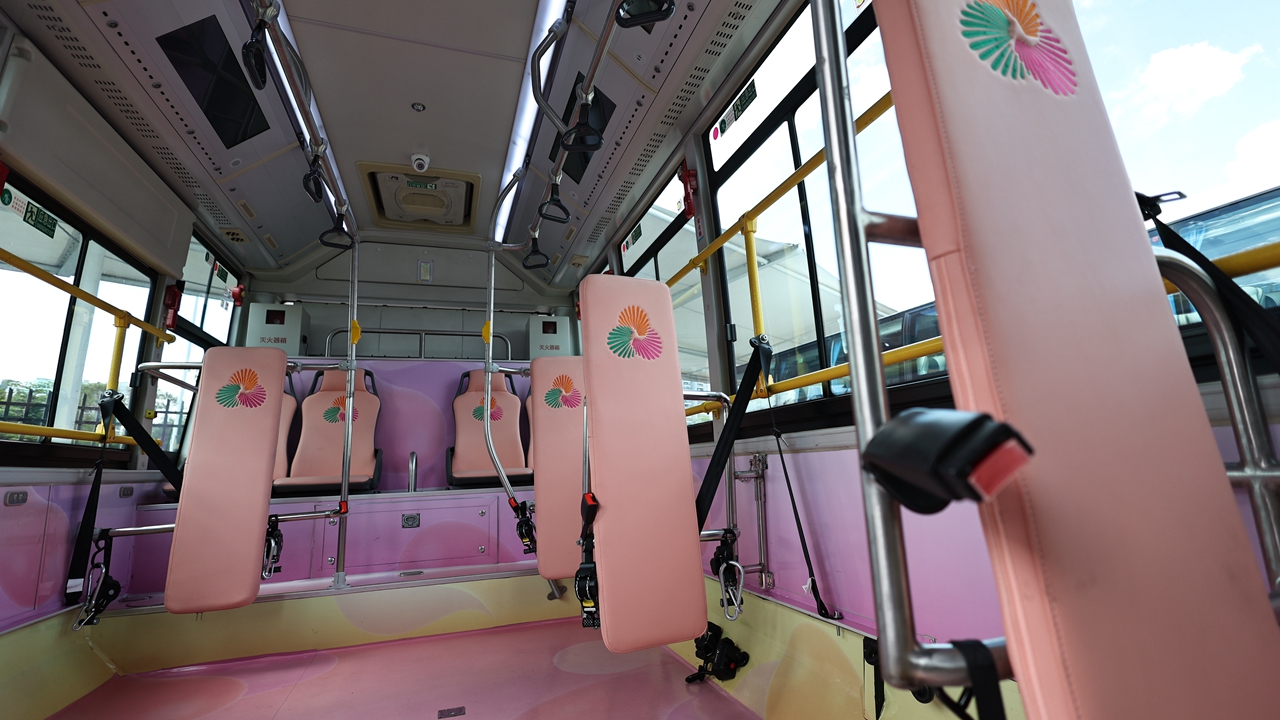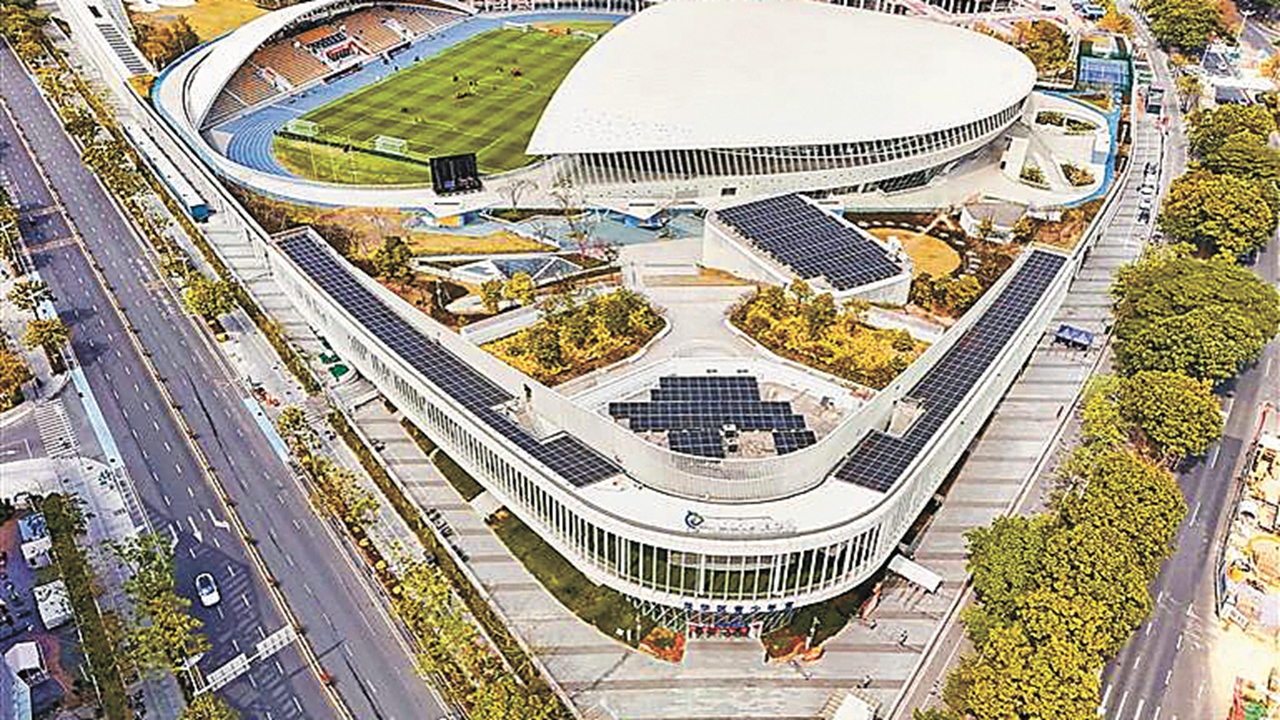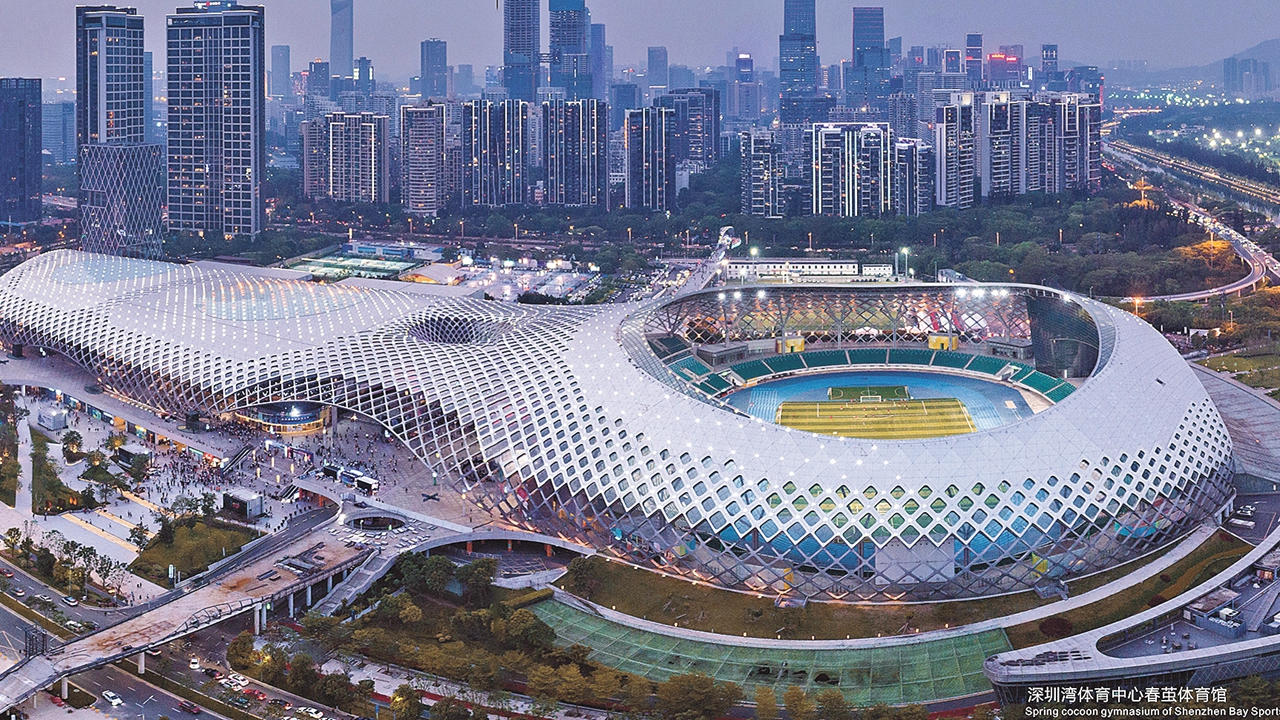Smart technologies power 15th National Games
Writer: Windy Shao | Editor: Lin Qiuying | From: Original | Updated: 2025-10-20
Technology runs deep in Shenzhen’s DNA. As one of the host cities of the 15th National Games, this innovation-driven metropolis has seamlessly woven smart technologies into every aspect of the event — from venue management and traffic coordination to fair competition, spectator engagement, and sustainability.
High technology has become the invisible yet powerful thread running through the Games, transforming traditional sports operations into intelligent, efficient, and low-carbon systems. The city’s innovations are setting new national benchmarks for a truly “tech-powered Games.”
Smart venues
Shenzhen’s commitment to smart infrastructure is best reflected in its new-generation sports venues.
The Guangming International Equestrian Center, China’s largest timber-structure sports building, adopts prefabricated modular construction for speed and sustainability. Its 66-meter glulam (glued laminated timber) span — the nation’s longest for a sports facility — minimizes steel use and cuts carbon emissions across the building’s lifecycle.
An aerial view of the Guangming International Equestrian Center. File photos except otherwise stated
Inspired by traditional Chinese wooden architecture, the roof design promotes natural ventilation. At the heart of the facility lies a fiber-sand arena system, scientifically mixed with special polymer fibers and selected quartz sand, according to the center’s management. This surface provides excellent cushioning, shock absorption, and traction stability for horses.
At the Shenzhen Sports Center Stadium, a total of 4,207 signal antennas and 1,767 wireless access points (APs) form a dense, high-speed “sensing network.” Even with 40,000 spectators live-streaming simultaneously, the network remains smooth and stable.
Inside the stadium’s Smart Command Center, Shenzhen’s homegrown BIM (Building Information Modeling) + GIS (Geographic Information System) technology powers a digital twin system. This system compresses the 68,000-square-meter venue complex into a 3D model that mirrors real-time operations.
With an “all-on-one-screen” management model, operators can monitor, predict, and control systems in real time. Air conditioning energy deviations exceeding 5% trigger automatic alerts, blocked fire exits prompt alarms within 20 seconds, and AI algorithms forecast crowd congestion 15 minutes in advance, allowing management to take prompt action.
AI-powered mobility
In Guangming District, the Smart Traffic Phase I Project has reached key milestones ahead of the Games, integrating artificial intelligence with real-world traffic management.
The project enhances 25 major intersections with dynamic smart-signal control and builds an intelligent command system linking five competition venues — the Shenzhen Youth Soccer Training Base, the Guangming International Equestrian Center, the Equestrian Cross-Country Course, a Freestyle BMX venue, and a Racing BMX venue.
Fifty in-vehicle terminals will enable real-time communication between vehicles and the cloud. The system will realize critical updates such as traffic events and competition schedules, ensuring seamless mobility for Games-related vehicles.
Beyond the Games, these improvements are already easing daily congestion and paving the way for “AI + Transportation” innovation across the district. A centralized traffic data platform now integrates 11 major datasets — from traffic flow and parking to public transport — visualizing every detail of urban mobility in real time.
Seamless transport for all
To ensure punctual and inclusive travel during the National Games and the National Para Games, Shenzhen Bus Group has fully deployed an AI dispatching system managing shuttles and transfers between venues, hotels, and transport hubs.
At the core of the operation is the group’s Antuo Hill Fleet Smart Dispatch Center, which utilizes big data, AI algorithms, and 5G to achieve refined, real-time management of fleet operations.
The system features round-the-clock intelligent violation monitoring, which is capable of scanning up to 6,000 vehicles per minute. Using AI-driven tools and data verification, the system has achieved a 98% on-time rate during test operations, ensuring that every shuttle arrives and departs precisely as scheduled.

Wheelchair locks are seen inside a refitted accessible bus for the upcoming National Games. Liu Xudong
Recognizing the special mobility needs of some Para Games athletes, Shenzhen Bus Group has refitted accessible buses with ramps and wheelchair locks. Each vehicle is fitted with auxiliary tools and professional medical emergency kits. During the Games, a 24/7 “barrier-free service chain” has been established, with standby teams available around the clock to respond to any mobility assistance requests.
Adding to the city’s “Smart Games” appeal, driverless minibuses have been introduced as a highlight of the Games’ transport network. These autonomous vehicles operate on special shuttle routes connecting major competition venues, hotels, and commercial districts, providing athletes and spectators with a novel, tech-driven travel experience.
Shenzhen’s transportation strategy not only ensures punctuality and accessibility but also showcases the city’s commitment to technological innovation — making the 15th National Games a model of intelligent and inclusive urban transport.
Green energy
Sustainability is another hallmark of Shenzhen’s approach.

Rooftop solar panels on the Longhua Cultural and Sports Center.
At the Longhua Cultural and Sports Center, rooftop solar panels generate over 1 million kWh of electricity annually. The Shenzhen Bay Sports Center integrates building-integrated photovoltaic (BIPV) glass panels that admit daylight while producing clean energy.

An aerial view of the Shenzhen Bay Sports Center.
Four venues — the Shenzhen Bay Sports Center Stadium, Shenzhen Bay Sports Center Gymnasium, Longhua Cultural and Sports Center, and Yinhu Conference Center — have been built or upgraded to meet the standards of near-zero carbon buildings in accordance with the Guidelines for Near-Zero Carbon Emissions Zone Pilot Construction in Shenzhen.
Among them, the Shenzhen Yinhu Conference Center, which will host chess competitions, conferences, and receptions, is undergoing extensive renovations that will cut total building carbon emissions by over 40% compared to pre-renovation levels, with a renewable energy utilization rate of at least 8%.
Technology with a human touch
Technology in Shenzhen’s venues goes beyond performance — it embodies inclusiveness and empathy.
All competition venues have undergone specialized barrier-free renovations, equipped with AI navigation systems and intelligent assistive devices to ensure fully accessible services for athletes and spectators with disabilities.
From seating areas and restrooms to locker rooms, the venues demonstrate Shenzhen’s vision of a city of technology with a human touch, where innovation ensures fairness and warmth in equal measure.
Meanwhile, the Shenzhen Universiade Sports Center has undergone a comprehensive upgrade of its barrier-free facilities, adding accessible seating areas and retrofitting restrooms that previously did not meet new national standards. Independent accessible restrooms now feature spacious turning areas for wheelchairs, height-appropriate toilets and sinks, and sturdy safety handrails. The parking area has also been enhanced with accessible parking spaces and drop-off zones to ensure convenience for spectators with special needs.
Fair play, smarter Games
On the field, technology guarantees fairness and enhances the viewing experience.
In badminton competitions, AI-powered cameras automatically capture key moments and generate performance data for referees.
In track and field events, an AI smart detection system with a margin of error under 1 millisecond ensures highly accurate judgments.
Meanwhile, 5G + 4K live streaming combined with augmented reality (AR) lets fans track player movements and tactics on their smartphones in real time — supported by Shenzhen’s ultra-fast 5G infrastructure.
Building a complete innovation ecosystem
The city’s Smart Event Platform, developed by local tech firms, has revolutionized large-scale sports operations. Using big data and AI, it integrates ticketing, logistics, crowd management, and emergency response on a single platform. During test events, AI-powered heatmaps and predictive analytics cut waiting times and improved safety efficiency.
Leveraging its unique location, Shenzhen has pioneered cross-border event management with Hong Kong.
By deploying facial recognition, real-time positioning, and an innovative “pre-clearance and closed-loop management” model, the city achieved zero-delay, contactless customs clearance for people, vehicles, and equipment.
Behind Shenzhen’s tech-powered Games lies a robust innovation ecosystem.
The city’s organizing committee established a specialized technology task force to link corporate innovations with event demands.
Through this platform, 43 cutting-edge products from 31 local enterprises were showcased and deployed in real event scenarios — from AI lighting systems and panoramic cameras to drone performances and smart security screening.
The Games thus became a “showcase and proving ground” for Shenzhen’s sports tech industry, accelerating product upgrades and positioning the city as a national hub for sports technology innovation.
Sustainability defines post-Games vision
Sustainability defines Shenzhen’s post-Games vision. Among the 20 main competition venues, 14 are renovation projects, and all permanent facilities are expected to achieve 100% post-Games utilization.
For example, the Youth Soccer Training Base will be integrated with nearby green spaces to form a public sports and leisure park.
Technologies like digital twin management and smart energy control systems will continue to serve urban governance and public fitness programs.
By turning technology into the pulse of the 15th National Games, the city has not only delivered a smarter, greener, and more inclusive event — it has redefined what hosting a national sports spectacle in the digital age truly means.